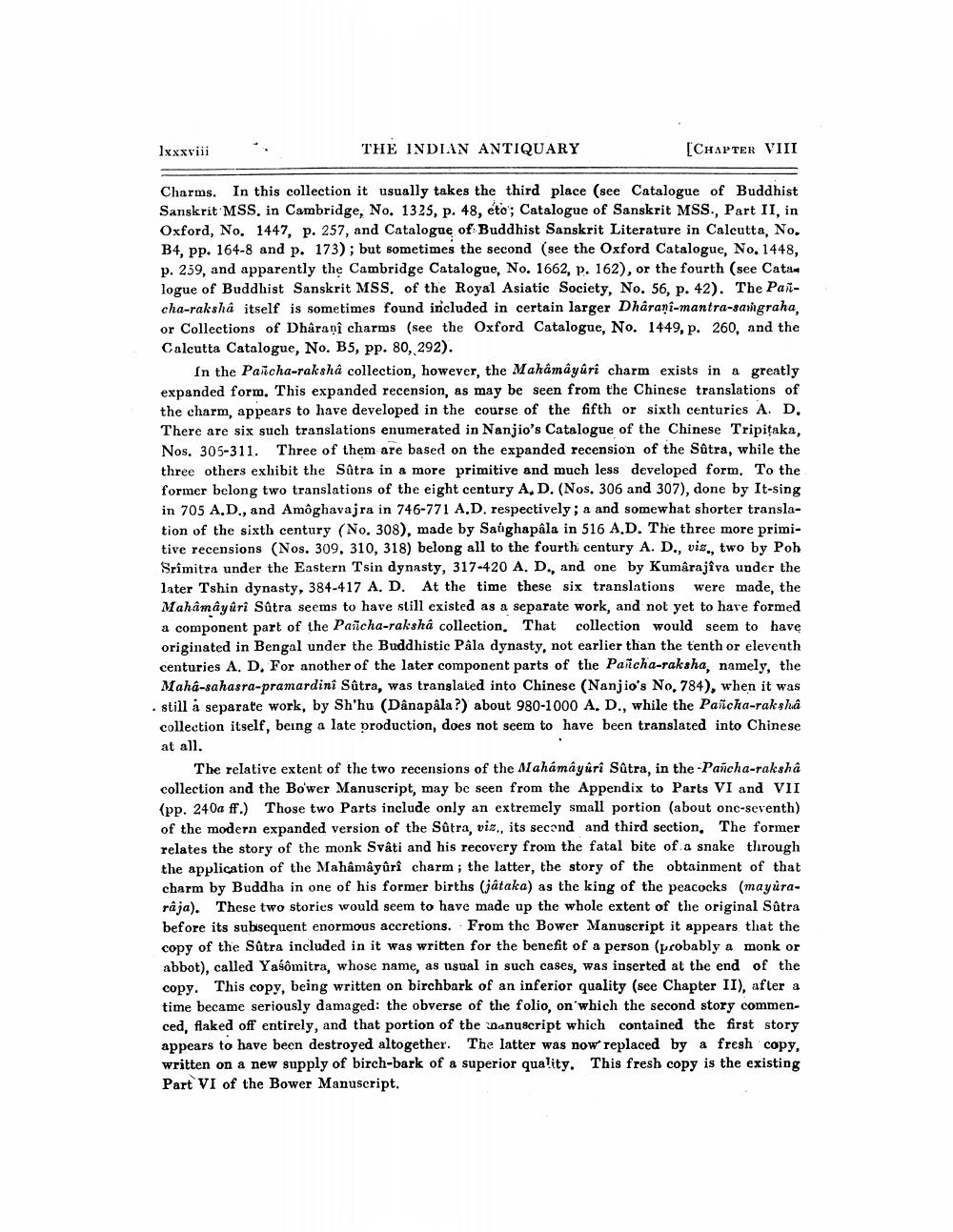________________ Ixxxviii THE INDIAN ANTIQUARY [CHAPTER VIII Charms. In this collection it usually takes the third place (see Catalogue of Buddhist Sanskrit MSS. in Cambridge, No. 1325, p. 48, eto; Catalogue of Sanskrit MSS., Part II, in Oxford, No. 1447, p. 257, and Catalogue of Buddhist Sanskrit Literature in Calcutta, No. B4, pp. 164-8 and p. 173); but sometimes the second (see the Oxford Catalogue, No. 1448, p. 259, and apparently the Cambridge Catalogue, No. 1662, p. 162), or the fourth (see Catam logue of Buddhist Sanskrit MSS. of the Royal Asiatic Society, No. 56, p. 42). The Pascha-raksha itself is sometimes found included in certain larger Dharani-mantra-sangraha, or Collections of Dharani charms (see the Oxford Catalogue, No. 1449, p. 260, and the Calcutta Catalogue, No. B5, pp. 80, 292). In the Pancha-raksha collection, however, the Mahamayure charm exists in a greatly expanded form. This expanded recension, as may be seen from the Chinese translations of the charm, appears to have developed in the course of the fifth or sixth centuries A. D. There are six such translations enumerated in Nanjio's Catalogue of the Chinese Tripitaka, Nos. 305-311. Three of them are based on the expanded recension of the Sutra, while the three others exhibit the Sutra in a more primitive and much less developed form. To the former belong two translations of the eight century A, D. (Nos. 306 and 307), done by It-sing in 705 A.D., and Amoghavajra in 746-771 A.D. respectively; a and somewhat shorter translation of the sixth century (No. 308), made by Saighapala in 516 A.D. The three more primitive recensions (Nos. 309, 310, 318) belong all to the fourth century A. D., viz., two by Poh Srimitra under the Eastern Tsin dynasty, 317-420 A. D., and one by Kumarajiva under the later Tshin dynasty, 384-417 A. D. At the time these six translations were made, the Mahamayuri Sutra seems to have still existed as a separate work, and not yet to hare formed a component part of the Pancha-raksha collection. That collection would seem to have originated in Bengal under the Buddhistic Pala dynasty, not earlier than the tenth or eleventh centuries A. D. For another of the later component parts of the Pancha-raksha, namely, the Maha-sahasra-pramardini Sutra, was translated into Chinese (Nanjio's No. 784), when it was . still a separate work, by Sh'hu (Danapala ?) about 980-1000 A. D., while the Pancha-raksha collection itself, being a late production, does not seem to have been translated into Chinese at all, The relative extent of the two recensions of the Mahamayuri Sutra, in the -Pancha-raksha collection and the Bo'wer Manuscript, may be seen from the Appendix to Parts VI and VII (pp. 240a ff.) Those two Parts include only an extremely small portion (about one-seventh) of the modern expanded version of the Sutra, viz., its second and third section. The former relates the story of the monk Svati and his recovery from the fatal bite of a snake through the application of the Mahamayuri charm; the latter, the story of the obtainment of that charm by Buddha in one of his former births (jataka) as the king of the peacocks (mayuraraja). These two stories would seem to have made up the whole extent of the original Sutra before its subsequent enormous accretions. From the Bower Manuscript it appears that the copy of the Sutra included in it was written for the benefit of a person (probably a monk or abbot), called Yasomitra, whose name, as usual in such cases, was inserted at the end of the copy. This copy, being written on birchbark of an inferior quality (see Chapter II), after a time became seriously damaged: the obverse of the folio, on which the second story commenced, flaked off entirely, and that portion of the nanuscript which contained the first story appears to have been destroyed altogether. The latter was now replaced by a fresh copy, written on a new supply of birch-bark of a superior quality. This fresh copy is the existing Part VI of the Bower Manuscript.




